Ocean Explorer Tim Taylor and his team ‘Lost 52 Expedition Team’ discovered, after about 75 years, the final resting place of the 49 sailors of the US Submarine S-28 (SS-133) off Oahu, Hawaii. The U.S. Navy recently validated the identity of the wreck, which Taylor located in 2017.
July 4, 2019 marks the 74th anniversary of the loss of the submarine, which was conducting exercises when she disappeared.
Identification of a navy gravesite is something Naval History and Heritage Command’s Underwater Archaeology Branch takes great care in doing
… commented Sam Cox, Director of Naval History and Heritage Command.
Mainly, the keel of the submarine was laid down in April of 1919, months after the end of the First World War. The S-Class submarine was commissioned on December 13, 1923 and spent 16 years taking part in various Navy exercises in the Caribbean and eventually the Pacific.
During the attack of the Pearl Harbor, December 7, she submarine was being overhauled at Mare Island Naval Shipyard, outside San Francisco, California. She was put into service during the World War II, while firstly, being sent to Alaska to defend the Aleutians against a possible Japanese invasion. By mid-November, S-28 arrived in Pearl Harbor and for the next seven months trained in the waters around the island.
On July 3, 1944, S-28 embarked on an antisubmarine warfare training exercise off the coast of Oahu, Hawaii. During the training, communication became sporadic and the boat sent her last communication to the Coast Guard cutter Reliance in the evening of July 4.
After that, a Navy Court of Inquiry wasn’t able to determine the cause of the loss. During her service during World War II, she completed six war patrols and earned one battle star.
The findings now present that the submarine now rests in about 8,700 feet of water, which made the location of the vessel impossible due to technological limitations of the era.
Records reflect that her sister ship, USS S-35, had been scuttled in that same area.
We now know the final resting place of our shipmates. This discovery helps to ensure their service will always be remembered, honored and valued and we hope provides some measure of closure to their families
… Mr Cox added.
Taylor’s team utilized advanced photogrammetry to create imaging that allows them to research the site long after they have returned to the dock. The data produced by their expedition was key in helping to confirm that we were looking at the S-28 and not the S-35.
Taylor, CEO of Tiburon Subsea Services, Inc., and director of non-profit Ocean Outreach, Inc. has a reputation for working with the latest in undersea technology and with the top specialists in underwater exploration. This is his fourth U.S. WWII submarine discovery since 2010 and is part of his ongoing “Lost 52 Project”.





























































